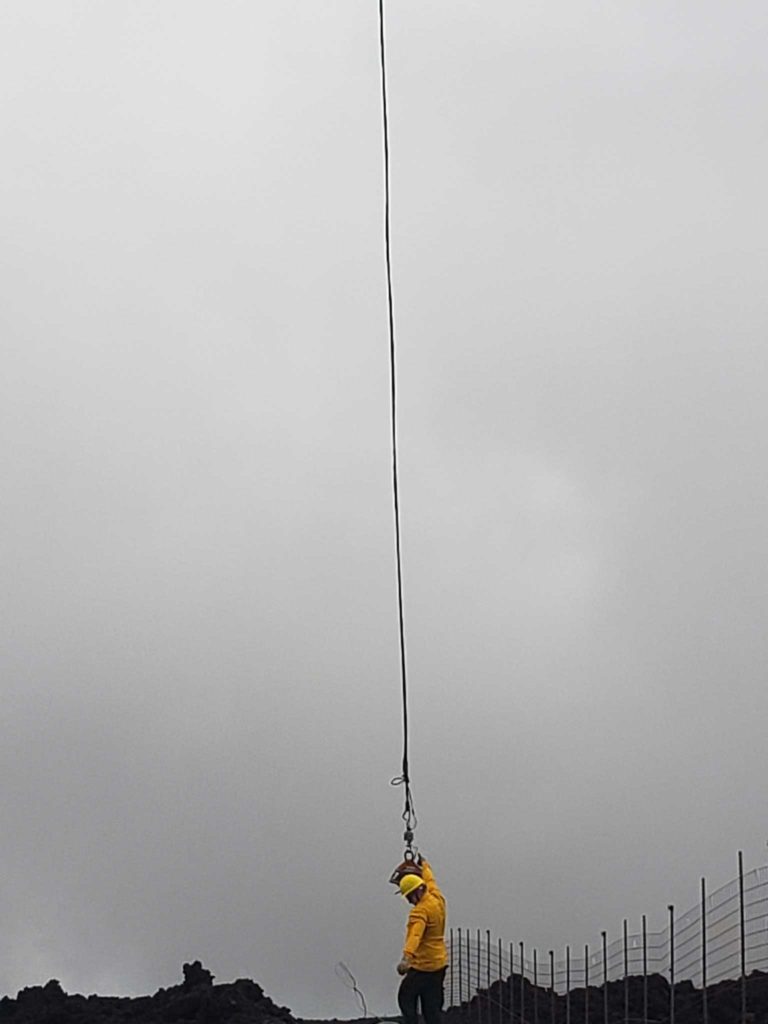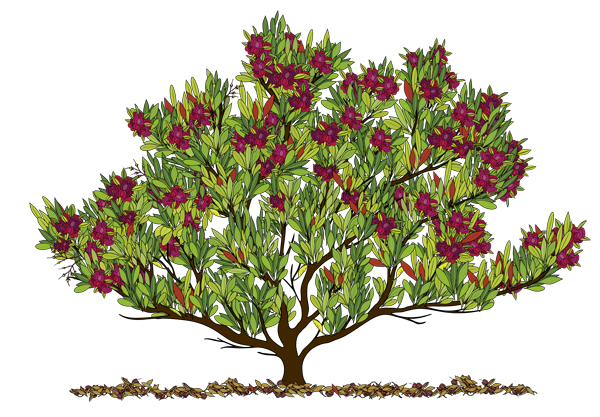
E kuahui like i ka hana
Let everybody pitch in and work together
What We Do
The TMA seeks to protect and recover native ecosystems to the point that they are self-sustaining, native species-dominated communities with secure populations of native plants and animals. Healthy native ecosystems are more resilient to threats such as climate change and are more capable of recovery after disturbance. Management work generally focuses on a landscape scale, which is cost effective and has potential for positive results on a large number of native species, both common and rare. The main land management activities are for the preservation of resources (e.g. biological, cultural, historical, etc.) and include feral ungulate removal and control, invasive species removal and control, monitoring and surveying of resources, and research.
The overall management goal of the TMA is to sustain the multiple ecosystem benefits provided by the three mountains of Kīlauea, Mauna Loa, and Hualālai by responsibly managing its watershed areas, native habitats and species, historical, cultural, and socio-economic resources for all who benefit from the continued health of the three mountains.
Threat Management
There are four main threats identified within TMA lands: fire, ungulates, invasive plants, and small animals. Our field crew works hard to mitigate these threats by installing and maintaining fences, removing ungulates within fenced areas, applying herbicide for weed control, and controlling small animal populations in order to restore and protect the health and function of our unique biological communities.
Click to learn more about the four major threats to our native ecosystems.
Fire
Uncontrolled wildfires have become an increasingly serious threat to native ecosystems in the TMA area. Wildfires leave the landscape bare and vulnerable to erosion and non-native weed invasions. Invasive weeds, particularly fountain grass (Pennisetum setaceum), which is a fire-adapted weed that has evolved to rely on fire for regeneration, are quick to reclaim burned areas, further changing the natural ecosystems of the area.
Ungulates
Pigs, goats, mouflon, sheep, and cattle are a major threat to the TMA area. Wild (feral) ungulates destroy native vegetation and prevent its regeneration through consumption, while accelerating the invasion of weed species through direct dispersal of seeds on their coats and in their droppings. In addition, pig wallows provide mosquito-breeding habitat that promotes the spread of avian malaria and pox – the two most deadly diseases of native forest birds, as well as human diseases. In some landscapes, feral ungulates have caused severe and extensive erosion, directly affecting both the forested uplands and nearshore coral reefs. Cumulatively, ungulate impacts cause the decline of intact native ecosystems that can affect watershed functions and jeopardize the future existence of rare and endangered plants and animals.
Invasive Plants
One of the major threats to native ecosystems and species in the TMA area is the uncontrolled spread of invasive non-native plants. These plants displace distinctive native flora, resulting in a loss of species diversity and eventually in more pronounced and permanent changes to ecosystem function such as alteration of primary productivity and nutrient cycling. Many invasive species completely replace native vegetation resulting in total loss of native habitats, thereby negatively affecting native bird, arthropod and snail communities.
Small Animals
Smaller animals also have the potential to become serious pests in the watershed. Feral cats and dogs, rats, mongooses, house mice, and certain non-native birds are known to consume or compete with native species. In addition, like ungulates, small mammals can affect water quality by serving as vectors of water-borne diseases.
Forests dominated by strawberry guava (Psidium cattleianum) lose 27% more water to evapotranspiration compared to native forests. This is equal to a loss of 13 inches in annual rainfall from watersheds.
-Takahashi et al. 2011 *
Restoration
TMA is actively restoring degraded lands; every year we plant about 8,000 seedlings of native understory and canopy species and also broadcast seeds. Important areas with ongoing or proposed restoration projects include Keauhou Forest and Lupea (land owned by Kamehameha Schools), Pu‘u Wa‘awa‘a (DLNR), and sections of the Pu‘u Maka‘ala Natural Area Reserve (DLNR).
The vast majority of the seedlings are grown in our greenhouse from seeds collected in areas where we will later focus our reforestation efforts. Reforestation occurs in two phases: first canopy species are planted, then once these are big enough to provide sufficient shade, understory species are planted.
Our planting techniques in wet forest sites have been perfected over the years; monitoring results show a survival rate of 85-95% depending on species.
Restoration efforts are often combined with environmental education and service learning activities.
116,884
The total number of seedlings planted by TMA staff and volunteers from 2006 – 2020
Watershed Protection
Watershed: An area of land, such as a mountain or valley, that catches and collects rainwater.
Mauka lands are important water catchment areas. They capture and transport water to the basal aquifer, where it is accessible for domestic, agricultural and industrial use.
Flooding and sedimentation problems in makai communities are often attributed to land management practices in mauka areas, although the severity of the problems is exacerbated by or lies at the root of poor planning and limited capacity of low elevation floodways.
TMA focuses its efforts on maintaining and re-establishing native forest cover in mauka areas to improve the capacity of the ground to absorb heavy rainfall. Maintaining a structurally-complex forest promotes infiltration and groundwater recharge and minimizes erosion and flooding.
Pōkiʻi ka ua, ua i ka lehua
The rain, like a younger brother, remains with the lehua
Said of the rain that clings to the forest where ʻōhiʻa grow
Endangered Species Protection
Due to the broad range of habitat types, many unique species can be found within the TMA. Lava flows from the active volcanoes isolate patches of forest called kīpuka, resulting in genetic divergence between isolated populations and speciation. Lava tubes in older flows host a diverse and unique cave invertebrate fauna. The TMA has some of the highest densities of native forest birds in the State due to the relative abundance of large tracts of intact, upper elevation native forests. Wet and mesic forests are home to a range of native forest birds including the endangered ‘akiapōlā‘au (Hemignathus munroi), Hawai‘i ‘ākepa (Loxops coccineus coccineus), and Hawaiʻi Creeper (Oreomystis mana) as well as unique invertebrates such as happy-face spiders and carnivorous caterpillars. The TMA also provides abundant habitat for animal species such as the ‘io (Buteo solitarius, Hawaiian hawk), nēnē (Branta sandvicensis, Hawaiian goose), and Hawai‘i’s only endemic land mammal, the ‘ōpe‘ape‘a (Lasiurus cinereus semotus). Seabirds such as the ‘ua‘u or dark-rumped petrel (Pterodroma phaeopygia sandwichensis) and the ‘akē‘akē or band-rumped storm petrel (Oceanodroma castro) nest on the upper slopes of Mauna Loa.
As broad-scale management actions are incrementally completed, the TMA dedicates more time and effort to monitoring and implementing specific recovery actions for rare and endangered species. The TMA identifies problems affecting native species stability and inventories the current status of certain native species populations. Once critical problems are identified, the TMA determines possible management options and how to implement them. These management actions help reduce or alleviate critical problems. Monitoring and evaluation helps us determine if we have reached our management objectives and informs our future decisions.
“Each time we lose another Hawaiian plant or bird or forest, we lose a living part of our ancient culture.”
-Nainoa Thompson, Polynesian Voyaging Society
Research & Monitoring
Monitoring is an important part of restoration that often gets overlooked. TMA gauges the effectiveness of conservation strategies by monitoring the response of native and non-native species to our management practices. Monitoring results track the progress of our restoration efforts by showing change in diversity of native species as well as changes in abundance of plant cover of native species. As research and monitoring help us gain an understanding of what constitutes a healthy native ecosystem, we will continue to further refine our management activities.
Monitoring programs include:
- Forest bird surveys
- Weed monitoring
- Vegetation surveys
Photo Gallery
*Citation
Takahashi, M., T. W. Giambelluca, R. G. Mudd, et al. 2011. Rainfall partitioning and cloud water interception in native forest and invaded forest in Hawai’i Volcanoes National Park. Hydrological Processes 25: 448-464.





















